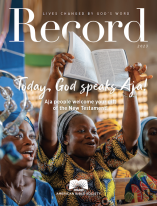New Year’s Challenge: What I Learned About My Son and the Bible
Practical Tips to Read Through the Bible with Kids
One of the most important spheres of influence in which we can lead Scripture engagement is within our own families. But often this is the most difficult place to start! That’s why we asked J.R. Briggs, founder of Kairos Partnerships, to give us some tips. In this three-part series, find out how leading his son in reading through the Bible in a year became one of his favorite leadership roles. Then try it yourself with this one-year Bible reading plan or another of your choosing.
I recently wrote about the year-long Bible reading challenge my 10-year-old son, Carter, and I took on this year and the numerous joys and benefits of the process. As a parent, you may be wondering if this is something you could pursue with your kids. Here are practical tips on how to make the most of your time reading the Bible together–including a handful of tips from Carter.
Know the personality of your child.
If you think your kid is up for the challenge, try it. But if you sense this might be too much, try reading just the New Testament. You may commit to smaller reading portions and not adding time constraints, if you think it won’t be helpful. If your child is not ready for this at age 10, consider waiting a year or two.
Encourage, don’t push.
Nobody likes to be forced to do something. Make it fun and make it a choice. Be an encourager in the faith development of your kid, but don’t add undue pressure or constraints. Demanding your kids to read a portion or shaming them for not doing it is an easy way to suck the joy out of the experience. If it works best in the mornings, read then. If it’s better before bed, do it at that time. Do what is most feasible for the rhythm of your family.
Choose a good reading plan.
You can read straight through Genesis to Revelation, but that may be more difficult, especially around month two—about the time readers get to the book of Leviticus. We discovered that utilizing a varied reading plan—specifically when you read an Old Testament passage, a New Testament passage, and a psalm or proverb on a daily basis—helped to give a varied experience so we didn’t get bogged down while reading a more difficult book. We found that if one passage was difficult or felt dry, then the additional passage or passages we read met us where we were that day. Mixing it up was incredibly helpful to keep it fresh.
Pick a translation that works for you.
There are many good translations available for use. We found the New Living Translation to be a good level for Carter (in fifth grade). But pick one that works best for you and your child. Just make sure to use the same one when reading together.
Ask questions.
Questions are the best way to grease the skids of conversation with your kid when reading. Ask questions that connect to their lives, such as, “How do you think you could live this out at school today?” “What classmate do you think you can show love to today or this week?” or “What do you think this says about how you treat your brother?” And, be willing to share what you’re learning and thinking about, too. Additionally, admit when a passage is confusing, difficult to swallow, or you aren’t sure what it means. You don’t have to be a Bible expert. When your child sees you wrestling with a difficult passage, your Bible reading experience will be more meaningful and engaging. Don’t sugarcoat the stories. Some of them are complex, difficult, and unnerving. And that’s okay.
Be flexible.
Use what works and ignore what doesn’t. Every kid is different. The goal is to encourage Bible reading together with your child. If you think the way Carter and I do it might work for you and your child, try it. If not, try something else.
Keep a notebook handy.
You don’t have to journal much—and you don’t have to journal every day. But having a notebook close by to record insights about what you read, learn, discuss, and pray about can be a wonderful tool and gift for you years later. For example, when reading Psalm 119, Carter and I wrote down all the ways David described Scripture throughout the psalm as a way to go deeper in our study.
Pick a spot.
We’ve found it helpful to have a designated place in the house to read every single time. You want to be comfortable when you are reading and have a place to put your Bible and notebook. We chose to sit on a couch in the reading room of our house, but you could choose a guest room, a nook in the living room, or in your child’s bedroom.
Celebrate every few months.
Set goals and when you meet them, celebrate! Since a year is a long time—and this may be the longest your child has ever worked toward a goal—break it down into smaller pieces so you can mark progress. Every three months, when we’ve completed another quarter of our reading, we drive to the local donut shop. We don’t read anything new that morning. Instead, we flip back through our Bibles to see what we’ve underlined and we pull out our notebooks to review what we’ve written down over the past several weeks.
Be willing to make adjustments
If you fall behind, consider a time when you can catch up a bit, maybe on the weekend. One family that joined us in the year-long challenge shared that they occasionally “binge-read” to catch up, taking 45 minutes to an hour to read through chunks of Scripture. Although they do this on occasion to catch up on their reading plan, they enjoy reading a large portion of God’s Story, which helps them see the bigger picture. While having a plan and a goal with a clear end date may be helpful (it was for us), be flexible and willing to adjust the timeline as needed to help your child. The goal is not to rush through the Bible, but to read it, understand it, reflect on it, and live it out. Whatever pace you need to experience Scripture that way, do it.
With that said, it’s also good to read ahead when possible, so you have a little bit of flexibility if you fall behind throughout the year. If your child is excited about the reading, by all means, keep going.
Remember what’s most important. The ultimate goal of this Bible reading challenge is for you and your child to know the God of the Bible. As one pastor said, “The goal is not to get all the way through the Bible, but for the Bible to get all the way through you.” The goal is not to check a box; it’s to be changed and formed as we understand our great God and God’s great story.
Start planning and saving.
We know that trips and vacations can be expensive. You certainly don’t have to go on a three-day trip, as Carter and I did, but you can still have fun-filled time together at a low cost. Be creative. Take a shorter trip. Drive instead of fly. Go camping. Stay with relatives. Also, start saving now. Our family started saving for the trip at the beginning of the Bible reading challenge, knowing that the trip would happen a year down the road.

J.R. Briggs
J.R. Briggs started Kairos Partnerships in 2011 where his role is expressed through coaching, consulting, speaking, teaching, equipping and writing to serve a wide variety of leaders, pastors, churches, non-profits, ministries, companies and denominations. Over the past several years, he has invested in kingdom leaders in over 23 states from over 40 different denominations. In addition to starting Kairos Partnerships, he planted The Renew Community, received a master’s degree in Missional Theology at Biblical Theological Seminary, and is currently working on a Doctor of Ministry degree at Biblical. His doctoral thesis focuses on how question-asking in leadership can advance God’s mission. He is an author, co-author and contributed to nine books that seek to equip and care for kingdom leaders. J.R. and his wife Megan have been married for over 16 years and have two sons, Carter and Bennett.
Thanks to the support of our faithful financial partners, American Bible Society has been engaging people with the life-changing message of God’s Word for more than 200 years.
Help us share God's Word where needed most.
Connect with our Bible engagement blog for leaders and receive a Bible-reading Habit Guide for your community.









